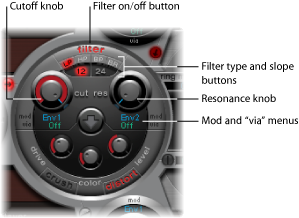Using Ultrabeat’s Multimode Filter
Ultrabeat features a powerful multimode filter that can dramatically, or subtly, alter the timbre of your drum sounds.

- Filter (On/Off) button: Activates or deactivates the entire Filter section. Deactivating the Filter section makes it easier to hear adjustments to other sound parameters, as the filter always heavily affects the sound. If the Filter label is red, the filter is engaged. If gray, the filter is disabled.
- Filter Type buttons: Switch the Filter between lowpass, highpass, bandpass or band-rejection filter types. See Choosing the Ultrabeat Filter Type (LP, HP, BP, BR).
- Filter Slope buttons (12 and 24): These buttons switch the filter between different slopes. See Setting the Ultrabeat Filter Slope,
- Cutoff and Resonance knobs: Determine the cutoff/center frequency and resonance/bandwidth of the filter. See Using Ultrabeat’s Filter Cutoff Parameter and Using Ultrabeat’s Filter Resonance Parameter.
- “Mod” and “via” menus: Determine the modulation source (and via source) for the Cutoff and Resonance parameters. See Working with Modulation in Ultrabeat.
Choosing the Ultrabeat Filter Type (LP, HP, BP, BR)
Ultrabeat’s filter can operate in several modes, allowing specific frequency bands to be filtered (cut away) or emphasized.

Select one of the following buttons to choose a filter type:
- LP (lowpass): This filter type allows frequencies that fall below the cutoff frequency to pass. When set to LP, the filter operates as a lowpass filter. The slope of the filter can be set to 12 or 24 dB/octave in LP mode.
- HP (highpass): This filter type allows frequencies above the cutoff frequency to pass. When set to HP, the filter operates as a highpass filter. The slope of the filter can be set to 12 or 24 dB/octave in HP mode.
- BP (bandpass): The frequency band directly surrounding the center frequency (set with the Cutoff knob) is allowed to pass. All other frequencies are cut. The Resonance parameter controls the width of the frequency band. The bandpass filter is a two-pole filter with a slope of 6 or 12 dB/octave on each side of the center frequency of the band.
- BR (band-rejection): The frequency band directly surrounding the center frequency (set with the Cutoff knob) is rejected, while the frequencies outside this band can pass. The Resonance parameter controls the width of the rejected frequency band.
Setting the Ultrabeat Filter Slope
Most filters don’t completely suppress the portion of the signal that falls outside the frequency range defined by the Cutoff parameter. Frequencies that are located close to the cutoff frequency are generally reduced less than those that are farther away. The higher the slope value, the more apparent the level difference is between frequencies that are near to the Cutoff frequency and those that are farther away from it.
The slope (curve) chosen for the Filter expresses the amount of rejection in decibels per octave. The Filter offers two different slopes: 12 dB and 24 dB per octave. The steeper the slope, the more severely the level of signals below the cutoff frequency are affected in each octave.
Using Ultrabeat’s Filter Cutoff Parameter
The Cutoff Frequency (Cut) parameter controls the brilliance or determines the center frequency of the signal.
In a lowpass filter, the higher the cutoff frequency is set, the higher the frequencies of signals that are allowed to pass.
In a highpass filter, the cutoff frequency determines the point where lower frequencies are suppressed, with only upper frequencies allowed to pass.
In a bandpass/band-rejection filter, the cutoff frequency determines the center frequency for the bandpass or band-rejection filter.
Using Ultrabeat’s Filter Resonance Parameter
The Resonance (Res) parameter emphasizes or suppresses portions of the signal above or below the defined cutoff frequency, or determines the width of the band that surrounds the cutoff frequency.
In a lowpass filter, Resonance emphasizes or suppresses signals below the cutoff frequency.
In a highpass filter, Resonance emphasizes or suppresses signals above the cutoff frequency.
In bandpass/band-rejection filters, resonance determines the width of the frequency band that surrounds the center frequency (set with the Cutoff Frequency parameter).